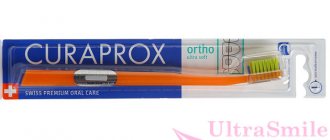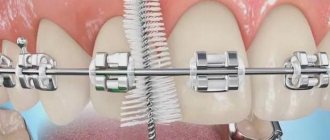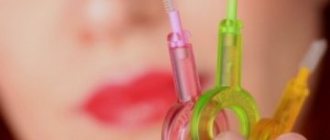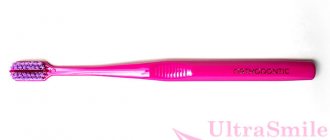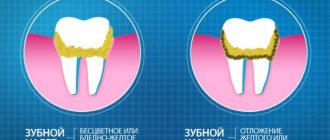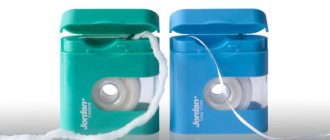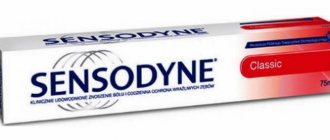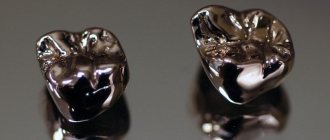For these purposes, various means are provided (special brushes, dental floss, irrigators, etc.).
And one of such effective devices is brushes for braces .
They are designed to clean the interdental space and braces from stuck food particles.
Also, brushes have a massaging function and, thereby, prevent bleeding gums.
For your information! Today they are produced in a wide variety (in size and shape) and everyone can choose the option that suits personal preferences and certain needs.
Why do you need to use special brushes for cleaning with braces?
It is worth using brushes for cleaning, because they are able to eliminate even the smallest particles of food , which inevitably remain in the interdental space and in the braces themselves .
Ordinary this 100% .
As a result, colonies of pathogenic microorganisms form in the oral cavity, subsequently leading to the initial stage of caries and other adverse consequences.
Keep in mind! Regular use of these brushes helps keep your teeth clean and healthy.
At the same time, the brace system used retains a well-groomed appearance longer.
Reviews
The health of our teeth is a litmus indicator of overall health. Therefore, choosing care products is far from an idle task. The result depends on how correctly it is done.
If you already have experience using interdental brushes, please share your impressions in the comments to this article.
If you find an error, please select a piece of text and press Ctrl+Enter.
Tags: dental brushes
Did you like the article? stay tuned
Previous article
How should you use dental floss?
Next article
Dental caries: symptoms, stages of the disease and photos
What happens if you don't use it?
If you do not use special brushes for cleaning, then in the future there may be such negative consequences as:
- Formation of tartar (due to the accumulation of plaque in hard-to-clean places).
- Darkening and thinning of tooth enamel.
- The emergence and development of caries.
- Darkening of the metal arches of the bracket system itself.
To avoid various risks, it is recommended to use such brushes regularly. Otherwise, the method does not guarantee 100% results.
What are dental floss and brush used for?
Floss and brush solve a number of problems:
- help remove pieces of food from hard-to-reach places;
- remove soft plaque, preventing the formation of caries, tartar, gingivitis and bad breath.
It would seem that these two items perform the same function, but no.
Each tooth in the mouth does its job. The incisors bite off the food, the fangs tear it into small pieces, the chewing teeth grind it into porridge, so that the food bolus then goes further into the stomach.
Due to the fact that the functions of teeth are different, their shape is also different and the interdental spaces are also different.
The front teeth - incisors and canines - have even spaces. Thread is ideal for cleaning them. We'll talk about the correct cleaning technique below.
The chewing teeth (those located further) have uneven spaces; they may have indentations that are not visible to us. In this case, dental floss will be ineffective because it will only be able to clean the joints of the teeth, but will not reach the grooves.
A thread can't do it, but a brush can. This is because its flexible bristles compress in narrow areas between the teeth, and expand in wide areas. This way no surface will be missed.
Therefore, dental floss is ideal for cleaning the front teeth, and brushes are ideal for cleaning the back teeth.
Types of devices
You should know! Orthodontic brushes are classified according to several criteria. So, the following varieties are distinguished:
- By bristle hardness : soft, medium and hard. Patients with hypersensitive teeth are recommended to use brushes with soft bristles.
- The shape of the bristles : cylindrical, curved and conical. Cylindrical bristles have the same length over the entire surface of the rod and are intended not only for braces, but also for cleaning wide interdental spaces and caring for gums. Curved - the most expensive option, in which the rod and handle have a semicircular shape. This type of device is considered the most effective means of cleaning braces. Conical, in turn, have cone-shaped bristles (the longest bristles are located at the base, and the shortest at the top). They can be used for daily cleaning of braces and teeth.
- Handle length : short and long. In this case, experts advise focusing solely on your preferences (what length of handle will be most comfortable to hold).
- By size of interdental spaces : small, medium and wide. In this case, the size is selected by the hygienist (after measuring the interdental space).
- By length of the bristles : with short and long bristles. The length of the short bristles is 1 mm and is used for cleaning narrow lateral edges, the long bristles are 3 mm, indicated for wide interdental spaces.
- By product length : there are sizes XS, S, M, L and XL in increasing order (accordingly, size XL is the largest).
- Operating principle : manual and electric. The second option is considered more effective in terms of cleaning braces and tooth enamel from plaque and food debris.
It is worth noting! A dentist or hygienist will help you choose the best brush option.
After all, convenience and comfort during the cleaning process is the key to a healthy and beautiful smile.
Selection rules
When purchasing a brush, you should pay attention to the following parameters:
- The length of the device itself .
There are 5 sizes available, and the optimal length is selected based on age. Thus, for children, a product with the shortest working part (designated S) is recommended. The maximum size is designated XL. Advice: it is very difficult to determine on your own exactly how long a brush is required. It is best to do this together with a doctor: after measuring the interdental distance, he will determine the desired size. - Villi length . Here you should focus on the size of the interdental space. Thus, for crowded units, it is recommended to use models with short villi (1 mm), and for trema and diastemas - with a length of 3 mm or more. It is also necessary to take into account the presence of orthodontic structures, implants and dentures. Products with short bristles are best for cleaning.
- Villi hardness . The devices are available with 2 types of bristles: soft and medium hard. Soft ones are approved for use for children, for periodontal hypersensitivity and for cleaning implants.
- The material from which the rod for attaching the bristles is made. Plastic or metal is used to make it. For weak and inflamed periodontal tissue, dentists recommend a brush with a plastic rod, since it is elastic and does not injure the mucous membrane and soft tissues.
- Handle length . This parameter is associated with the individual preferences of patients, i.e. whoever is more comfortable. Many manufacturers add stops, protrusions and rings to the handle, making it more comfortable.
Tip: a device with a smooth handle is difficult to hold in your hand when cleaning, so it is better to give preference to models with protrusions or stops on the handle.
We must not forget about quality. Your choice should be made on products from well-known global manufacturers who have proven themselves to be positive over the years.
How to choose the right one?
When choosing a suitable device, you must consider the following important nuances :
- Length of bristles - if the teeth fit tightly together, then it is better to choose a product with short bristles. If there are small gaps between the teeth, then a product with long bristles would be an ideal option.
- Brush length - small sizes are suitable for children, larger sizes for adults (L, XL).
- Bristle hardness - dentists advise choosing products with medium bristle hardness. But people with sensitive or damaged enamel should give preference to soft brushes.
- The length of the handle of the product should be based on personal considerations of comfort during cleaning. Some people find it convenient to hold a product with a short handle, others with a long handle.
- Product quality - it is advisable to choose products from well-known brands, after studying consumer reviews.
According to dentists, the most convenient to use are cone-shaped brushes.
They not only effectively clean braces, but also interdental spaces, eliminating plaque and bacteria accumulation.
General tips for use
Stay up to date! Using these products is quite simple. However, it is necessary to take into account a number of the following rules:
- Before using the brush, be sure to brush your teeth in the usual way (using toothpaste and a regular brush).
- Bring the device to the interdental spaces (hold the device perpendicular) and gently massage the required areas of the teeth and the brace system (especially metal arches).
- It is advisable clean after every meal .
- After each use, the brush must be rinsed with warm water and then closed with a cap (included in the kit).
- Carry out the procedure without using special cleaning products (paste or tooth powder).
- Change the product as often as possible (if the fibers lose stiffness), on average once every 2-4 weeks .
In the first days of using the brush, the gums may bleed a little , which is quite normal for the adaptation period.
Remember ! However, if such symptoms persist for a week and your teeth hurt, you should consult a doctor for advice.
Who needs a teeth brush?
The product improves oral hygiene and is therefore useful to absolutely anyone. It is especially important for people to use it:
- who have braces installed;
- wearing leveling plates;
- prone to rapid formation of plaque and tartar;
- with large interdental spaces;
- with malocclusions that do not allow proper oral hygiene;
- those suffering from frequent gum disease;
- with crowded teeth;
- with hard-to-reach indigenous units;
- accustomed to drinking coffee;
- addicted to tobacco.
If a person buys a dental brush, he will not go wrong. This device will immediately become his favorite assistant. Be sure to try it!
Sequence of application
the cleaning device as follows:
- Rinse the product under running water.
- the brush one by one into the interdental spaces and, using soft circular movements, clean the enamel surface with a regular brush . Do not move up and down (like dental floss). Do not touch the incisors.
- Then place the bristles of the product between the arch of the bracket system and the enamel . Make light movements (clockwise).
- Rinse the brush with warm water and close the cap. Remove until next use.
Remember! To maintain oral hygiene, you can also use special rinses, for example, Listerine, etc.
They will help cope with plaque and prevent caries.
Content:
- How they work
- Who needs a teeth brush?
- Classification
- What to look for when choosing
- How to use it correctly
- Yorshik is a friend of braces
Recently, dental brushes have become increasingly popular. These are special dental devices designed for the highest quality cleaning of interdental spaces. Outwardly, they are similar to standard household brushes, but they are hundreds of times smaller.
Popular manufacturers
Today, many manufacturers produce special brushes for cleaning braces, but not all of them are of high quality.
So, the most effective products are from the following brands :
- Lacalut (lacalut) - products are equipped with a metal rod made of hypoallergenic materials, covered with insulating plastic. This reduces trauma during use. Average price: 300 rubles and above.
- Colgate Total (colgate) – a distinctive feature of this product is that the products are produced in a set, which includes brushes with different bristle lengths. The cost of the product is on average 250-270 rubles.
- Miradent - are available in the form of a set that includes 4 brushes with ultra-soft bristles and a wire rod. The products differ from each other in the length and thickness of the bristles, as well as the diameter of the rod. The cost of the set is 500 rubles.
- Oral-B (oral bi) – products are cylindrical and cone-shaped, sold in small containers (include 1 pc.). Also available in sets. The price ranges from 250 to 400 rubles.
- Curaprox (curaprox) - products are made from a special alloy that is used in the surgical industry. The brushes produced under this brand are of high quality and have a long service life. Therefore, they cost around 1000 rubles.
Products from the above brands are not only highly effective, but also absolutely safe to use.
Rating
Brushes for brushing teeth appeared relatively recently, but they very quickly became popular among users. Therefore, there are many manufacturers of these devices.
The most popular manufacturers are: Colgate, Oral-b, Lacalut, President, Curaprox. To understand which company is suitable for the user, you should consider the following ranking of popular and high-quality models.
Oral-B Interdental Starter Kit
An excellent kit that consists of the following components:
- interdental brush holder;
- replaceable conical nozzle;
- replaceable cylindrical nozzle.
Food debris located in wide gaps between teeth, around braces, implants or bridges can be easily removed with a cylindrical nozzle. To clean narrow and hard-to-reach places, use a conical nozzle, which will ideally clean the oral cavity.
The ergonomic handle holder fits perfectly in the hand, which allows for more precise and easy manipulation while cleaning your teeth. This set is purchased once, after which you only need to change the attachments, which are sold in abundance in stores in packs of 6 pieces. packaged.
Characteristics:
- diameter of the conical brush – 2.7 mm;
- diameter of a cylindrical brush – from 3 to 6.5 mm;
- length of brushes – 2.5 cm;
- brush length – 18.5 cm;
- the cost of the set is 250 rubles.
Advantages:
- affordable price;
- nozzles in the amount of 2 pcs. different shapes;
- convenient handle holder;
- A good starter kit with all the necessary equipment.
Flaws:
- rapid wear of nozzles;
- may not be suitable for very narrow gaps between teeth.
Colgate Total (2, 4, 5 mm)
The set will allow you to keep not only dental spaces clean, but also orthodontic structures.
Thanks to the set, which includes 3 nozzles with different diameters of bristles, you can easily clean the areas of your mouth that need it:
- 4 and 5 mm nozzle cleans braces, dentures and bridges;
- A nozzle with a diameter of 2 mm will clean the interdental space well.
The line includes a set consisting of 3 identical brushes with a diameter of up to 2 mm. The set includes 3 attachments with a small plastic handle and a handle holder that can be easily removed.
The brush and handle are made in the shape of a curved drop, which can be easily taken with the index finger and thumb, and can also be used without a holder. The plastic case can easily replace a storage container.
To do this, it will be enough to place the brush with the head inward, which will make it more compact and allow you to easily place it in your purse or pocket.
This set is very convenient to take with you to a restaurant, cafe, or just on a visit, where it is not possible to clean the oral cavity immediately after eating, since this will only require warm water. The average price fluctuates around 220 rubles.
The set is characterized both on the positive and negative side:
| pros | Minuses |
| Good equipment | The brush bends easily |
| Compactness | Wire with bristles becomes unusable very quickly |
| Nozzles of various diameters | |
| Ability to clean briquettes | |
| Budget price |
Lacalut Interdental
The German company Lacalut has gained the trust not only of ordinary citizens, but also of dentists. In addition to mouth rinses, pastes, toothbrushes and flosses, it produces interdental brushes. The line contains 4 sets with diameters from 2 to 4 mm in an amount of 5 pieces.
The bristles are made from high quality nylon and are attached to a surgical alloy wire coated with insulating plastic. This combination completely eliminates the risk of electrostatic discharge and helps avoid unpleasant sensations.
Cylindrical brushes are attached to a small non-removable handle made of plastic. Additionally, the kit includes a transparent cap that easily attaches to the back of the handle, extending it for easier access to hard-to-reach places.
Depending on the purpose, you can select the appropriate diameter of the bristles. Sizes XS and S clean the interdental space well, while M and L are suitable for people with braces. Some people use several kits at once to achieve maximum effect. The price of the product is 350 rubles.
The advantages of the device include the effective removal of food debris and plaque, the choice of bristle diameter, and the fact that it is suitable for braces.
The disadvantage is considered to be rapid wear and an inconvenient removable handle.
Curaprox CPS 457
This set of brushes consists of the following components:
- 4 removable brushes of various diameters;
- travel case;
- pen holder.
The handle is made of high quality plastic and has an ergonomic shape for maneuvering in hard-to-reach places. The nozzle is attached to the handle using a click, which allows you to securely combine the structural elements.
Nylon bristles are coated with silicone and made of wire containing a medical alloy. This allows you to effectively remove food debris and plaque without causing injury to your gums.
The travel storage case is equipped with holes for ventilation, which prevents bacteria from multiplying on the surface of the brush. The price of a hygiene item is 900 rubles.
The advantages of the product are:
- 4 removable attachments;
- high quality materials;
- stylish design with travel case;
- removable ergonomic handle;
- cleaning the oral cavity without causing injury.
The disadvantages include the high price.
PresiDent Soft sticks
PresiDent brushes are used not only by those who have braces, crowns and bridges, but also by those who thoroughly monitor the condition of their oral cavity. S-size bristles are able to easily penetrate the narrowest crevices of the interdental space.
The brush does not contain metal components, so it can be used daily without fear of receiving a current discharge. The bristles have a slight stiffness, which allows them to remove plaque and bacteria around the gums and massage them pleasantly.
Despite all their fragility and small size, one package lasts quite a long time. The kit includes a mini-container that allows you to conveniently transport and store brushes. The price fluctuates around 350 rubles.
The advantage is considered to be compactness and the absence of metal components. Disadvantages include rapid wear of the brush and a short handle holder.
What is an electric brush for braces?
An electric brush is a device for cleaning braces and interdental spaces .
The bristles of the product vibrate due to the built-in electric motor.
Power comes from either a battery or a rechargeable battery.
Using this brush allows you to quickly and easily clean braces and tooth enamel from plaque and stuck food debris .
Therefore, this type of brushes is becoming increasingly popular.
Useful video
From this video you will learn how to properly care for braces:
Brushes for cleaning braces are an important element of complete oral care. They provide excellent protection of the enamel and bracket system from plaque and pathogenic bacteria .
At the same time, they are easy to use. With their help, you can not only protect yourself from problems such as caries and tartar, but also extend the life of the product.
The most important thing is to make the right choice by first studying the characteristics of a particular brush. Then convenience and comfort during the cleaning process are ensured.
Indications
A brush is an additional device for dental care, but dentists recommend that some categories of people use it. The main indications for use of the product are:
- wearing braces, dentures, implants and other orthodontic and orthopedic structures;
- large spaces between molars;
- crowding and irregular shape of crowns;
- presence of malocclusion and gum disease;
- discoloration of enamel due to smoking, consumption of products with dyes;
- accelerated formation of bacterial plaque due to impaired acid-base balance in the oral cavity.
In addition, it is advisable to use a brush daily to prevent various dental diseases, as an addition to a brush.
Read how much it costs to insert a tooth and what the cost of prosthetics is made up of. Click here if you are interested in how you can restore tooth enamel at home.
At this address https://dr-zubov.ru/lechenie/desny/v-chem-prichina-i-chto-delat-otoshla.html you will learn what to do if the gum moves away from the tooth.
